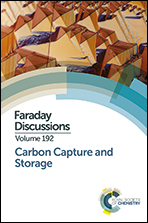Accelerated degradation of MOFs under flue gas conditions
Abstract
The zero length column (ZLC) technique is used to investigate the stability of Mg- and Ni-CPO-27 metal–organic framework (MOF) crystals in the presence of water and humid flue gas. The design of the ZLC enables the stability test to be conducted over a considerably shorter time period and with lower gas consumption than other conventional techniques. A key advantage over other experimental methods for testing the stability of adsorbents is the fact that the ZLC allows us to quantify the amount adsorbed of every component present in the gas mixture. The developed protocol is based on a two-stage stability test. The samples were first exposed to a humid carbon dioxide and helium mixture in order to study the effect of water on the carbon dioxide adsorption capacity of the samples. In the second stage the samples were exposed to a flue gas mixture containing water. From the preliminary water stability test, the Ni-sample exhibited the highest tolerance to the presence of water, retaining approximately 85% of its pristine CO2 capacity. The Mg-MOFs deactivated rapidly in the presence of water. The Ni-CPO-27 was then selected for the second stage of the protocol in which the material was exposed to the wet flue gas. The sample showed an initial drop in CO2 capacity after the first exposure to the wet flue gas, followed by a stabilisation of the performance over several cycles.
- This article is part of the themed collection: Carbon Capture and Storage

 Please wait while we load your content...
Please wait while we load your content...